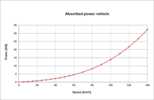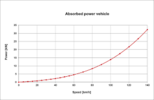It's the increase compared to the total If the total vehicle usage increased 10% then fuel usage would increase 10% (assuming constant conversion efficiency), but aero or road load are not the total load. If your rear brakes are dragging, 10 MPH of headwind will have a lower percentage impact on range than if they aren't.You're mushing different things together. Aero drag and rolling resistance are both part of what auto engineers call "road load". Obviously if you increase aero 10% and hold RR constant, road load will increase by less than 10%. But it's the same for EVs and ICE, thus has no bearing on this discussion.
The engine, drivetrain and parasitic losses in your graphic are not part of road load. They are a side effect of producing power. Increase power and you increase those losses.
A full hybrid like Prius has all the losses shown in your graphic. The engine losses are a bit lower, say 61-65% vs. your 71-75%. So your logic should still apply. But it doesn't -- Prius suffers almost exactly the same range hit due to headwinds, higher speeds, etc. as a BEV.
Why do Prius and BEV suffer similar range hits while conventional ICE sometimes suffers a lesser hit? It's not the absolute level of tank-to-wheel efficiency -- BEV is vastly more efficient than either Prius or conventional ICE. It's due to the way that efficiency changes with power output. Prius and BEV efficiency is pretty constant over a wide range of highway conditions. Conventional ICE efficiency can vary meaningfully at highway speeds, though, and it generally improves as road load increases. It's a second order effect, e.g. my 7.3% vs. 10% range hit example. But it can be noticeable. And in fact that was an early criticism of Prius -- MPG dropped off more dramatically at very high speeds than conventional ICE drivers were used to.
TL;DR - it's not the difference in efficiency that causes EV range hit to sometimes be worse than conventional ICE, it's how that efficiency varies. If you had a vehicle with a constant 1% power train efficiency it would suffer the same range hit as a BEV.
If chemical to mechanical conversion is 35% efficient and the engine requires 10 HP just to turn, transmission takes 2 HP and a certain speed requires 20HP due to road load it's 32HP / .35 = 91.5 HP of gas
10% more road load = 22HP + 12 Parasitics = 34HP / .35 = 97 HP or a 6% fuel increase / range decrease
EV: 90% battery to mechanical, 2 HP drivetrain, 18HP road load = 20 / .9 = 22.2 HP battery
+10% = 19.8 HP road + 2 = 21.8 HP/ .9 = 24.2 battery or a 9% battery usage increase





